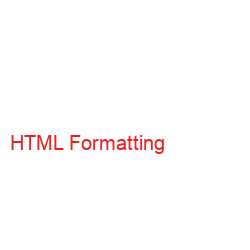<html>HTML Formatting: Basic Examples
HTML, or HyperText Markup Language, is the standard language for creating and designing websites. One of the key aspects of HTML is formatting text and other elements on a webpage. In this post, we’ll cover some of the basic formatting techniques in HTML.
1. Headings
HTML provides six levels of headings, from H1 (the most important) to H6 (the least important). To create a heading, you can use the `
` to `
` tags. For example:
“`
This is a Heading 1
This is a Heading 2
This is a Heading 3
This is a Heading 4
This is a Heading 5
This is a Heading 6
“`
2. Paragraphs
To create a paragraph, you can use the `
` tag. For example:
“`
This is a paragraph.
“`
3. Lists
HTML supports two types of lists: ordered lists (numbered) and unordered lists (bulleted). To create an ordered list, you can use the `
- ` tag and the `
- ` tag for each list item. For example:
“`
- First item
- Second item
- Third item
“`
To create an unordered list, you can use the `
- ` tag and the `
- ` tag for each list item. For example:
“`
- First item
- Second item
- Third item
“`
4. Bold and Italic
To make text bold, you can use the `` tag. For example:
“`
This is bold text.
“`
To make text italic, you can use the `` tag. For example:
“`
This is italic text.
“`
5. Links
To create a hyperlink, you can use the `` tag. The `href` attribute is used to specify the link’s destination. For example:
“`
This is a link
“`6. Images
To add an image, you can use the `
` tag. The `src` attribute is used to specify the image’s source. For example:
“`

“`These are just a few of the basic formatting techniques available in HTML. With these tools, you can create and design simple webpages. There are many more formatting options available in HTML, such as tables, forms, and CSS styling. With practice and experience, you can create complex and dynamic websites using HTML.</html>











